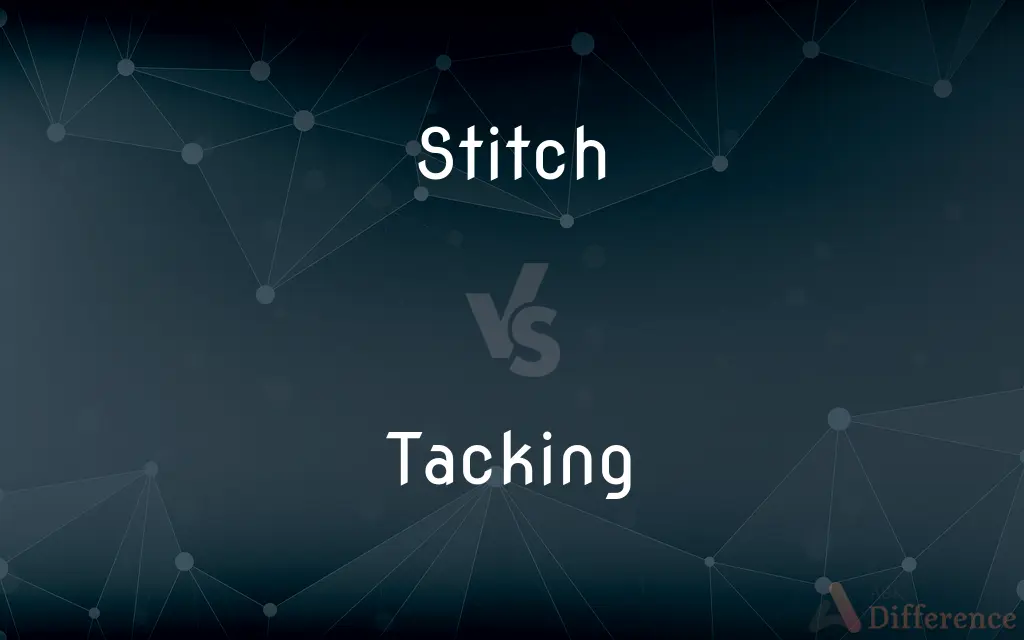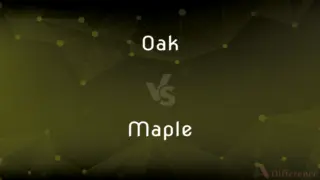Stitch vs. Tacking — What's the Difference?
By Fiza Rafique & Maham Liaqat — Updated on April 20, 2024
Stitching refers to the process of sewing to join fabric together or create designs, while tacking is a temporary sewing method used to hold fabric in place before final stitching.

Difference Between Stitch and Tacking
Table of Contents
ADVERTISEMENT
Key Differences
Stitching is a broad term for the act of sewing, which involves creating or repairing fabric or garments with thread and needle. In contrast, tacking is a specific type of stitch used temporarily to hold pieces of fabric together until more permanent stitches are applied.
In the context of sewing techniques, stitching can include various forms such as running stitch, backstitch, or decorative stitches that are intended to be permanent. On the other hand, tacking (often referred to as basting) is designed to be removed and is typically larger and looser than regular stitches.
Stitching can be done by hand or machine and is essential for constructing garments, quilting, or embroidery. Whereas, tacking is usually performed by hand to ensure precision in the temporary placement of fabric layers or components, like aligning stripes or positioning zippers.
Durability is a key characteristic of stitching, as it must withstand wear and regular laundering. In contrast, tacking stitches are not meant to endure and are removed once the final sewing is completed, leaving no trace.
While stitching is a fundamental sewing skill required for a wide range of textile projects, tacking is a technique particularly valued in tailoring and dressmaking for achieving accurate alignment and fit before final sewing.
ADVERTISEMENT
Comparison Chart
Purpose
To permanently join or decorate fabrics
To temporarily hold fabrics in place
Durability
Designed to be durable
Not intended to be durable
Techniques
Includes running stitch, backstitch, etc.
Generally simple, large, loose stitches
Application
General sewing, quilting, embroidery
Used in tailoring, dressmaking
Removal
Not intended to be removed
Removed after final stitching is complete
Compare with Definitions
Stitch
To create embroidery patterns with needle and thread.
She stitches beautiful flowers on tablecloths.
Tacking
To position pieces of fabric before final sewing.
Tacking helps ensure the stripes align perfectly.
Stitch
To join or attach by sewing.
The tailor stitched the patches onto the jacket.
Tacking
To hold fabric layers together temporarily.
He used tacking stitches to keep the lining in place.
Stitch
To sew or fasten together with thread.
She used a fine needle to stitch the delicate silk.
Tacking
To make preliminary stitches in tailoring.
The tailor tacked the pieces together to check the fit.
Stitch
To make sewing stitches.
He spent the evening stitching up the torn curtains.
Tacking
To temporarily sew with long, loose stitches.
She tacked the hem before sewing it permanently.
Stitch
To mend or repair by sewing.
I need to stitch the hole in my jeans.
Tacking
To use stitches that are meant to be removed.
After tacking the quilt layers, she began the quilting process.
Stitch
A single complete movement of a threaded needle in sewing or surgical suturing
Made multiple stitches.
Tacking
A short, light nail with a sharp point and a flat head.
Stitch
A single loop of thread or yarn made with an implement such as a sewing or knitting needle.
Tacking
A rope for holding down the weather clew of a course.
Stitch
A single loop or knot of thread used in closing a wound or incision in surgery; a suture.
Tacking
A rope for hauling the outer lower corner of a studdingsail to the boom.
Stitch
A way of arranging the threads in sewing, knitting, crocheting, or suturing
Used a purl stitch.
Tacking
The part of a sail, such as the weather clew of a course, to which this rope is fastened.
Stitch
A sudden sharp pain, especially in the side.
Tacking
The lower forward corner of a fore-and-aft sail.
Stitch
(Informal) An article of clothing
Wore not a stitch.
Tacking
The position of a vessel relative to the trim of its sails.
Stitch
(Informal) The least part; a bit
Didn't do a stitch of work.
Tacking
The act of changing from one position or direction to another.
Stitch
To fasten or join with stitches.
Tacking
The distance or leg sailed between changes of position or direction.
Stitch
To mend or repair with stitches
Stitched up the tear.
Tacking
An approach to accomplishing a goal or a method of dealing with a problem.
Stitch
To decorate or ornament, as with stitches
"The sky was stitched with stars" (Mario Puzo).
Tacking
A large, loose stitch made as a temporary binding or as a marker.
Stitch
To fasten together with staples or thread.
Tacking
Stickiness, as that of a newly painted surface.
Stitch
To make stitches; sew, knit, crochet, or suture.
Tacking
To fasten or attach with a tack or tacks
Tacked the carpet down.
Stitch
A single pass of a needle in sewing; the loop or turn of the thread thus made.
Tacking
To fasten or mark (cloth or a seam, for example) with a loose basting stitch.
Stitch
An arrangement of stitches in sewing, or method of stitching in some particular way or style.
Cross stitch
Herringbone stitch
Tacking
To put together loosely and arbitrarily
Tacked some stories together in an attempt to write a novel.
Stitch
An intense stabbing pain under the lower edge of the ribcage, brought on by exercise.
I've got a stitch. I'm going to have to stop and rest.
After about fifteen minutes I got terrible stitch.
Tacking
To add as an extra item; append
Tacked two dollars onto the bill.
Stitch
A local sharp pain (anywhere); an acute pain, like the piercing of a needle.
A stitch in the side
Tacking
(Nautical) To bring (a vessel) into the wind in order to change course or direction.
Stitch
A single turn of the thread round a needle in knitting; a link, or loop, of yarn
Drop a stitch
Take up a stitch
Tacking
To change the direction of a sailing vessel, especially by turning the bow into and past the direction of the wind
Stand by to tack.
Stitch
An arrangement of stitches in knitting, or method of knitting in some particular way or style.
Tacking
To sail a zigzag course upwind by repeatedly executing such a maneuver.
Stitch
A space of work taken up, or gone over, in a single pass of the needle.
Tacking
To change tack
The ship tacked to starboard.
Stitch
A fastening, as of thread or wire, through the back of a book to connect the pages.
Tacking
To change one's course of action.
Stitch
(by extension) Any space passed over; distance.
Tacking
Present participle of tack
Stitch
(obsolete) A contortion, or twist.
Tacking
(sewing) Loose temporary stitches in dressmaking etc.
Stitch
(colloquial) Any least part of a fabric or clothing.
To wet every stitch of clothes
She didn’t have a stitch on.
Tacking
(nautical) The act of changing tack.
Stitch
(obsolete) A furrow.
Tacking
(legal) A union of securities given at different times, all of which must be redeemed before an intermediate purchaser can interpose a claim.
Stitch
The space between two double furrows.
Tacking
(legal) The joining together of consecutive periods of possession of property, especially between squatters in cases of adverse possession.
Stitch
To form stitches in; especially, to sew in such a manner as to show on the surface a continuous line of stitches.
To stitch a shirt bosom.
Tacking
A union of securities given at different times, all of which must be redeemed before an intermediate purchaser can interpose his claim.
Stitch
To sew, or unite or attach by stitches.
To stitch printed sheets in making a book or a pamphlet.
Tacking
Loose temporary stitches
Stitch
(intransitive) To practice/practise stitching or needlework.
Tacking
(nautical) the act of changing tack
Stitch
(agriculture) To form land into ridges.
Stitch
To weld together through a series of connecting or overlapping spot welds.
Stitch
To combine two or more photographs of the same scene into a single image.
I can use this software to stitch together a panorama.
Stitch
(more generally) To include, combine, or unite into a single whole.
Stitch
A single pass of a needle in sewing; the loop or turn of the thread thus made.
Stitch
A single turn of the thread round a needle in knitting; a link, or loop, of yarn; as, to let down, or drop, a stitch; to take up a stitch.
Stitch
A space of work taken up, or gone over, in a single pass of the needle; hence, by extension, any space passed over; distance.
You have gone a good stitch.
In Syria the husbandmen go lightly over with their plow, and take no deep stitch in making their furrows.
Stitch
A local sharp pain; an acute pain, like the piercing of a needle; as, a stitch in the side.
He was taken with a cold and with stitches, which was, indeed, a pleurisy.
Stitch
A contortion, or twist.
If you talk,Or pull your face into a stitch again,I shall be angry.
Stitch
Any least part of a fabric or dress; as, to wet every stitch of clothes.
Stitch
A furrow.
Stitch
An arrangement of stitches, or method of stitching in some particular way or style; as, cross-stitch; herringbone stitch, etc.
Stitch
To form stitches in; especially, to sew in such a manner as to show on the surface a continuous line of stitches; as, to stitch a shirt bosom.
Stitch
To sew, or unite together by stitches; as, to stitch printed sheets in making a book or a pamphlet.
Stitch
To form land into ridges.
Stitch
To practice stitching, or needlework.
Stitch
Sewing consisting of a link or loop or knot made by drawing a threaded needle through a fabric
Stitch
A sharp spasm of pain in the side resulting from running
Stitch
Fasten by sewing; do needlework
Common Curiosities
What is the main purpose of stitching?
Stitching is primarily used to permanently join or decorate fabric.
What is the difference between tacking and basting?
There is no difference; tacking and basting are terms used interchangeably.
What is tacking used for in sewing?
Tacking is used to temporarily hold fabric in place before final sewing.
Why remove tacking stitches?
Tacking stitches are removed because they are not meant to be part of the final, visible stitching.
Are there different types of stitching techniques?
Yes, there are many stitching techniques, including straight, back, chain, and cross-stitches.
What materials can you stitch?
You can stitch a wide variety of materials, including fabric, leather, and even paper.
Can tacking be done with a sewing machine?
Yes, tacking can be done with a sewing machine set to long stitch lengths.
Is stitching applicable to both hand and machine sewing?
Yes, stitching can be performed both by hand and with a sewing machine.
How do tacking stitches differ from regular stitches?
Tacking stitches are longer, looser, and easier to remove than regular stitches.
What types of projects require tacking?
Tacking is often required in tailored garments and complex sewing projects for alignment.
How do you perform tacking correctly?
Tacking should be done with even, loose stitches that can easily be removed.
What tools are needed for tacking?
Basic sewing supplies like a needle, thread, and sometimes a basting gun are used for tacking.
Can tacking be decorative?
Generally, tacking is not decorative; it's functional and temporary.
Share Your Discovery

Previous Comparison
Biofuel vs. Biomass
Next Comparison
Oak vs. MapleAuthor Spotlight
Written by
Fiza RafiqueFiza Rafique is a skilled content writer at AskDifference.com, where she meticulously refines and enhances written pieces. Drawing from her vast editorial expertise, Fiza ensures clarity, accuracy, and precision in every article. Passionate about language, she continually seeks to elevate the quality of content for readers worldwide.
Co-written by
Maham Liaqat













































